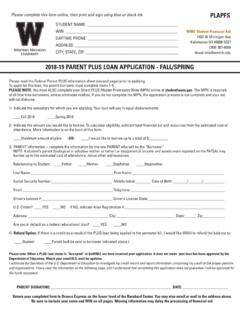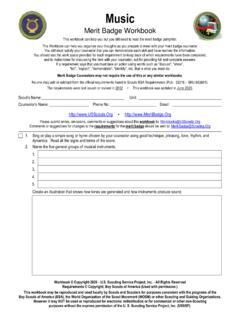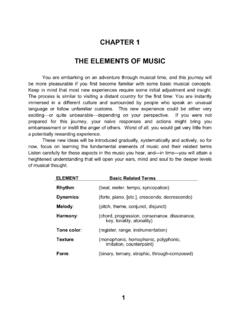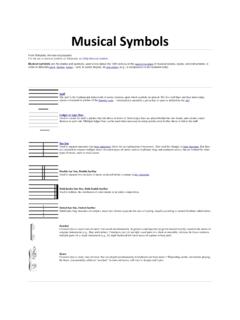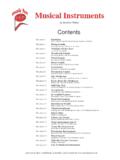Transcription of APPENDIX MUSICAL INSTRUMENTS & ENSEMBLES
1 143 APPENDIX MUSICAL INSTRUMENTS & ENSEMBLES MUSICAL INSTRUMENTS OF THE WESTERN WORLD Every MUSICAL instrument or voice has its own characteristic sound. Once you become familiar with these, you will start to hear music "in color." The HUMAN VOICE Though not an "instrument" in the strictest sense the voice is one of the most colorful vehicles for MUSICAL expression. It is certainly the most personal of all INSTRUMENTS (each voice is unique) and the only one capable of presenting both words and MUSICAL sound simultaneously. (Voices can also make many noise-like sounds that are colorful in their own right). Voices are classified by their tone-color, register and range: soprano (highest female voice) mezzo-soprano (rich female voice mixing soprano and alto colors) contralto or "alto" (lowest female voice) countertenor (a very high male voice) tenor (high male voice) baritone (rich male voice mixing tenor and bass colors) bass (very low male voice) Young boys whose voices have not yet "changed" can sing in the soprano or alto ranges.
2 Boy sopranos have a sweet sound that is much less intense than a female soprano. Instrumental families can also be categorized by the designations soprano, alto, tenor and bass), as described below. APPENDIX : MUSICAL INSTRUMENTS & ENSEMBLES 144 The STRING Family The string family is comprised of INSTRUMENTS whose sounding mechanism is directly contacted by the hands. Many stringed INSTRUMENTS are played with a bow, which greatly increases the possible sounds that the instrument can produce. The most common types of stringed INSTRUMENTS include: the violin family (violin, viola, violoncello and double bass) the harp the guitar family (guitar, bass guitar, banjo, mandolin, ukulele) various folk INSTRUMENTS such as the dulcimer or the psaltery the ancient viol family (ancestors to the violin family) The violin family became the core of the modern orchestral string section in the mid- 1600s. The standard range categorization of this family is as follows: Violin (soprano), Viola (alto), Cello (tenor), Double Bass (bass) Note: The piano and the harpsichord ARE NOT string INSTRUMENTS , since the player's hands do not come in direct contact with the strings.
3 CelloViolaViolinDouble BassThe Violin Family APPENDIX : MUSICAL INSTRUMENTS & ENSEMBLES 145 The WOODWIND Family The woodwind family is comprised of wooden INSTRUMENTS that the player must blow into to create a MUSICAL sound. Most members of the modern woodwind family are "reed" INSTRUMENTS (a piece of wooden reed attached to its mouthpiece adds character to the sound). The complete woodwind family became a standard part of the orchestra by the early 1800s. Common woodwind INSTRUMENTS include: the piccolo (very high) and various-sized flutes the oboe and the "English" Horn (a tenor oboe) various-sized clarinets the bassoon and contrabassoon (very low bassoon) various-sized saxophones various-sized recorders (ancestors to the modern flute family) The standard range categorization of this family is as follows: Flute (soprano), Oboe (alto), Clarinet (tenor) Bassoon (bass) Note: The organ is essentially a wind instrument (when its keys are pressed, compressed air is passed through a series of pipes) BassoonFluteOboeClarinet(B-flat)Tenor SaxophoneCommon Woodwind INSTRUMENTS APPENDIX : MUSICAL INSTRUMENTS & ENSEMBLES 146 The BRASS family The brass family is comprised of powerful metallic INSTRUMENTS that must be blown into by the player to make a MUSICAL sound.
4 The tone-color (timbre) of most brass INSTRUMENTS can be altered by the use of various types of mutes which are inserted into the large end of the instrument. Until the invention of the VALVE, brass INSTRUMENTS could only produce a limited number of pitches, which lessened their usefulness to composers. Instrument builders experimented with various VALVES that would avail more pitch varieties to these INSTRUMENTS . Many modern brass INSTRUMENTS have a system of 3 VALVES that can be depressed in various combinations to produce different pitches. The modern "rotary" valve was invented in the early Romantic period (c. 1830) an invention that made the brass family more responsive and reliable. As a result, Romantic composers made greater use of the brass family. The most common types of brass INSTRUMENTS include: various-sized trumpets (use valves to change pitch) various-sized trombones (use a slide instead of valves to change pitch) the "French Horn" (use valves to change pitch) the Tuba a very low brass instrument (uses valves to change pitch) The standard range categorization of this family is as follows: Trumpet (soprano), Alto Trombone (alto), Tenor Trombone and upper French Horn (tenor), Bass Trombone and low French Horn (bass) Common Brass InstrumentsTubaTenor TromboneTrumpet (B-flat)mouthpiecevalvesbellwater key ("spit valve")tuning slideFlugelhornSousaphoneFrench Horn APPENDIX : MUSICAL INSTRUMENTS & ENSEMBLES 147 The PERCUSSION family The percussion family is comprised of INSTRUMENTS that must be struck by an object (usually a mallet, a stick, or a hammer) in order to produce a MUSICAL sound.
5 Composers have made greater use of percussion color in their scores since the 1880s. Percussion INSTRUMENTS fall into two types (pitched and non-pitched): PITCHED Percussion (can play specific notes): timpani (various-sized kettle drums) piano and harpsichord (an internal object hits the strings) orchestra bells ("chimes"), glockenspiel (a rack of metal bars), and handbells xylophone (an arranged series of various-sized metal bars) marimba (an arranged series of various-sized wooden bars) vibraphone ("vibes" an electric "xylophone" with windpipes) NON-PITCHED Percussion (no distinct pitch is created): bass drum snare drum castanets cymbals triangle tambourine gong (a large, suspended "Chinese" cymbal) Both pitched and non-pitched percussion INSTRUMENTS can be classified by range, for example: Triangle/Glockenspiel (soprano), Snare Drum (alto), Timpani (tenor), Bass Drum (bass) XylophoneCymbalsChimes (Tubular Bells)TimpaniTriangleBass DrumSnare DrumSome Common Percussion INSTRUMENTS APPENDIX .
6 MUSICAL INSTRUMENTS & ENSEMBLES 148 The PIANO The piano, the most prominent of all keyboard INSTRUMENTS , is actually a percussion instrument, because it employs an intricate key-mechanism that engages a felt-tipped hammer to attack the string. The piano can produce a variety of dynamic contrasts and tone colors, depending on how hard/fast the keys are depressed by the player. The original piano prototype was called a "Fortepiano," because it was capable of playing both loud and quiet (unlike a harpsichord which has no dynamic variance.) ELECTRIC and ELECTRONIC INSTRUMENTS Various ELECTRIC INSTRUMENTS (such as electric guitars, keyboards and amplifiers) have risen to prominence in the late 20th century, primarily due to developments in popular music . ELECTRIC INSTRUMENTS , however, should not be confused with ELECTRONIC INSTRUMENTS true synthesizers that rely on digital and/or microchip computer technology. Synthesized INSTRUMENTS can simulate traditional MUSICAL sounds as well as create sounds that are completely original.
7 Many synthesized keyboards, guitars, drum machines and wind INSTRUMENTS can communicate with computers through a technology known as MIDI (" MUSICAL Instrument Digital Interface"). Synthesizers and the more traditional "Electric" keyboards and guitars have added new dimensions of color to modern music . Digital Synthesizer (Electronic)Electro-magnetic pick-upsVolume and Tone control knobsTremolo barElectric Guitar (Fender) APPENDIX : MUSICAL INSTRUMENTS & ENSEMBLES 149 COMMON ANCIENT INSTRUMENTS The VIOL Family (Ancestors to the modern violin family): These bowed INSTRUMENTS come in a variety of sizes, and they have a lighter sound than that of the modern violins. The LUTE Family (Ancestors to the modern guitar family): The lute is a pear-shaped guitar-like instrument with a rounded back and a short, wide fingerboard. The lute, and its larger relative the chitarrone (Bass-lute) were the most sophisticated polyphonic string INSTRUMENTS of the Renaissance. Ancient WIND INSTRUMENTS (ancestors to the modern woodwind family).
8 Recorders (the preferred wind INSTRUMENTS of the Renaissance period) are various-sized wooden INSTRUMENTS that play much like a flute, but are softer in sound. The shawm, the crumhorn, and the racket are raucous-sounding reed- INSTRUMENTS that are ancestors to the modern oboe and bassoon. Ancient BRASS INSTRUMENTS (ancestors to the modern Brass family). Sackbuts are trombone-like INSTRUMENTS of various sizes used in the Medieval, Renaissance and Baroque eras. The cornetto and the serpent are trumpet-like wooden and leather INSTRUMENTS that use finger holes instead of valves to produce their pitches. The natural horn is a valveless brass instrument that evolved into the modern "French horn." RecorderShawmSelected Ancient InstrumentsSerpentCrumhornLuteViol' da gambaAPPENDIX: MUSICAL INSTRUMENTS & ENSEMBLES 150 Ancient Keyboard INSTRUMENTS The harpsichord and organ were the most prominent types of keyboard INSTRUMENTS in the Renaissance and Baroque periods. The HARPSICHORD (an ancestor to the modern piano) The harpsichord's distinctive "plucked" sound is due to its unique key mechanism: When one of its keys is pressed, a quill attached to a lever plucks the respective string, producing a sharp, dry sound that dies away quickly.
9 The harpsichord was the most popular keyboard instrument of the Renaissance and Baroque periods. It is still used today by performers specializing in early music . The ORGAN The organ the most complex Western instrument ever devised is comprised of a series of wooden or metal pipes connected to one or more keyboards (called manuals) via a set of "stops" (mechanical levers or electrical switches that open or close air flow to the individual pipes). Before the advent of electric motors, the wind pressure had to be supplied by an assistant pumping a bellows (a corrugated air bag). This cross-section diagram of an 18th-century French organ, shows the hand-pumped air bellows and several manuals (keyboards) on the organ's console. A cut-away view of an interior church wall is located in the center of the diagram (the organist is to the right of the wall, the bellows operator is to the left of the wall).. APPENDIX : MUSICAL INSTRUMENTS & ENSEMBLES 151 MUSICAL ENSEMBLES It is essential that you remember the difference between an ensemble and a genre.
10 An ensemble (pronounced "ON-SAHM-BULL") is a group of musicians playing together. ENSEMBLES range in size from smaller groups, such as string quartets (four players), to larger ENSEMBLES such as the symphony orchestra. The "type" of piece that a musician plays (such as symphony, concerto, Mass, motet, etc.) is the genre (pronounced "GSHAN-RUH") the category of MUSICAL composition. For the most part, the terms for genres and ENSEMBLES are easily distinguishable. In a few cases, however, the same term can be used to describe BOTH a genre AND the ensemble that plays it. For example, the string quartet is a four-player chamber ensemble BUT it is also a genre. In other words, Beethoven's String Quartet in C minor is performed by an ensemble of four string players, but this work is also an example of the string quartet genre. The term symphony can also refer to BOTH a genre and the ensemble that plays it.



